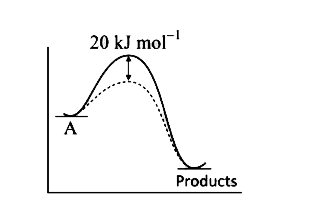For the following reaction,
A500K−−→ Products
A400K/catalyst−−−−−−−−→ Product
If (−d[A]dt)500K=−(d[A]dt)400K
no catalyst in presence of catalyst Then Ea is approximately :

A
200 kJ mol−1
B
100 kJ mol−1
C
20 kJ mol−1
D
120 kJ mol−1
Video Solution
Text Solution
The correct Answer is:B
k500=Ae−Ea/500R,k400=Ae−(∈a−20)/400R
Since k500=k400(∵d[A]dt∣∣∣_(500k)=d[A]dt∣∣∣400k)
∴e−Ea/500R=e−(Ea−20)/400R⇒Ea500R=Ea−20400R
|
Updated on:21/07/2023
Similar Questions
Knowledge Check
- Question 1 - Select One
For following reactions
A400K−−→ Product
A200K−−−−−→catalyst Product
it was found that the Ea is decreased by 20 kJ/ mol in the presence of catalyst. If the rate remains unchanged, the activation energy for catalysed reaction is ( Assume per exponential factor is same ) :A40 kJ/ molB20kJ /molC80kJ/molD35kJ/mol - Question 2 - Select One
For the following reactions. .
A600K−−→ Product
A400K−−−−→ catalyst Product It was found that the Ea is decreased by 40kJ / mol in the presence of catalyst . If the rate remains uncharged the activations energy for catalyzed reactions is [Assume per exponnetial factor is same:]A105 kJ/ molB120 kJ / molC75 kJ/molD135 kJ/mol - Question 3 - Select One
For following reactions A700K−−→Product
A500K−−→Product
it was found that the Ea is decreased by 30 kJ/mol in the presence of catalyst. If the rate remains unchanged , the activation energy for catalysed reaction if (Assume pre exponential factor is same)A75 kJ/molB105 kJ /molC135 kJ/molD198 kJ/mol
Consider the following reaction,
CH3COOH+HCOOHMnO−−→570K
Main product of this reaction isView SolutionAcetaldehyde 720 K−−→
The products of this reaction areView SolutionA consecutive reaction, AK1−−→BK2−−→C is characterised by:
View SolutionConsider the following reactions,
A+Bk1⇐⇒k−1C,C+Bk2−−→D
The rate in terms of −d[B]dt will beView SolutionIn the following first order reactions:
A+ReagentK1−−→Product
B+ReagentK2−−→Product
The ratio of K1/K2 when only 50% of B reacts in a given time when 94% of A has been reacted is:View Solution

